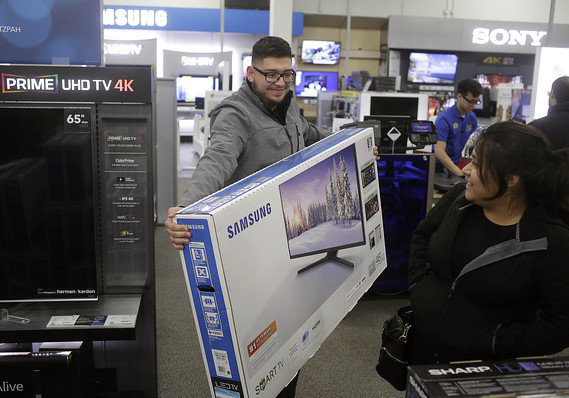The nature of Best Buy’s business – selling large appliances and pricey consumer electronics – helps draw foot traffic
Best Buy Co. Inc. is doing something most retailers wish they could do nowadays: they’re getting customers into stores.
About one-third of the consumer electronics retailer’s online sales are picked up in stores, according to David Silverman, senior director of corporates at Fitch Ratings, owing to the qualities of many of the items the company is selling.
Among the merchandise in Best Buy’s BBY, -0.91% inventory are large-screen televisions and cumbersome appliances. Even among some of the smaller items, there are high price tags. Many customers don’t trust an expensive item to be shipped through home-delivery channels and left on the front porch or outside an apartment door.
All of the company’s big-box stores have an in-store pickup area, according to details provided by Best Buy. And about 70% of Americans live within 15 minutes of a Best Buy store. Many items can be ready for pickup within 30 minutes, and many of the big-box stores have parking set aside for customers who are going to a store for a pickup.
And once customers are in the store, there’s a chance to sell them something more.
“So many items sold online have periphery items customers can purchase,” Silverman said. For instance, a device might need a portable case or additional cords. “It’s certainly an opportunity to sell a related or complimentary item.”
It’s an advantage that Best Buy might be able to hang on to for a while.
“Big-screen TVs and refrigerators aren’t getting any smaller,” said Silverman. “The concerns will likely remain, as well as the potential theft risk.”
Best Buy was the last major electronics retailer standing after the demise of Circuit City, and the bankruptcy of RadioShack, which worked in its favor. But it now faces competition from chains like Wal-Mart Stores Inc. WMT, -0.49% and Amazon.com Inc. AMZN, +1.01% that also sell consumer electronics at low prices. Plus, they’re always looking for ways to deliver more quickly and conveniently, including on the same day.
Best Buy had $4.8 billion in domestic online revenue in fiscal 2017, up 21% from the previous year, according to the retailer. Online revenue in the fourth quarter was $2.3 billion, accounting for 18.6% of the company’s fourth-quarter domestic revenue. Total domestic revenue for the quarter was $12.3 billion.
On Thursday, Best Buy reported first-quarter revenue of $8.5 billion, up from $8.4 billion the year prior. Domestic online revenue was $1.02 billion, up 22.5%, due to higher conversion rates and traffic the company said.
While Amazon offers everything with free two-day shipping, other retailers still charge for bulky items. That means, it might not be the cost of the item but the cost to have it delivered that is prohibitive.
“Buy-online-pickup-in-store in general has really taken off in the marketplace,” said Jim Prewitt, vice president of retail industry strategy at JDA Software, a retail and supply chain software company. He highlighted the “barriers” around delivering items that are large or fragile. “For a company like Best Buy to offer a full range of products online, to offer them with in-store pickup is also a benefit.”
And once a big appliance, like a washer and dryer, is in your home, most people don’t want to have to deal with a return.
“There’s a factor of convenience, being able to see the product you’re buying and get one last chance to see if it’s what you want before you walk out. Perhaps talk to a salesperson and find out if you need a different cable or a stand,” said Stefan Weitz, chief strategy officer at Radial, a retail technology provider.
Weitz warns against stores “bombarding” customers as they come in for a pickup in an attempt to generate an upsell. However, it’s an opportunity to have a “high-touch, high-value interaction,” no matter how brief, that will be useful to the customer.
Even with the pickup advantage, Wedbush is sticking with its underperform rating on Best Buy shares. Wedbush’s price target is $29, about 48% below its current trading level.
“Cost cuts and share repurchases have masked continuing revenue declines, but we expect comp declines to persist due to a lack of compelling new products while the possibility of heightened competition is a constant threat to gross margin,” analysts wrote in a Monday note. “With declining revenues and fewer cost cuts going forward, Best Buy has few levers other than buybacks to drive EPS growth in fiscal year 2018.”
SunTrust Robinson Humphrey said the company had a lot of hurdles in the first quarter, including the delayed tax refund and pressure from the HHGregg Inc.HGGGQ, +5.16% going out of business sales at 220 closing stores. Fifteen percent to 20% of Best Buy’s store base is close to an HHGregg store, according to SunTrust analysts.
“While good Nintendo 7974, +1.15% Switch sales likely helped, gaming isn’t that big a category for Best Buy,” SunTrust’s Monday note said. “Conversely, the sell-through of the 005930, +2.86% Galaxy 8 seemed ‘meh,’ in our estimation.
“Finally, we note that Best Buy is ‘all about’ the fourth quarter and isn’t as focused on maximizing profits in the seasonally weak first quarter.”
SunTrust rates Best Buy shares buy with a $53 price target.
Best Buy shares closed Thursday up 21.5%, and are up 91% for the past year. The S&P 500 index SPX, +0.31% has gained 15.5% for the last 12 months.
by Tonya Garcia

